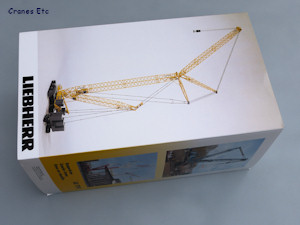 |
| The large Liebherr
box. |
 |
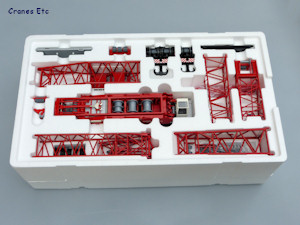 |
| The middle tray
contains the crane body, lattice sections and hooks. |
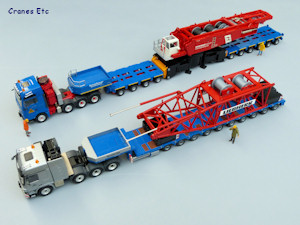 |
| The model makes
very good transport loads. The body of the crane is fixed
with transport
adaptors.
|
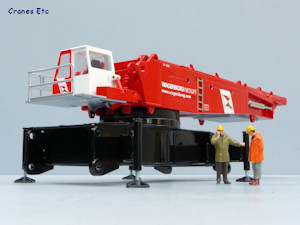 |
| The crane
offloaded and standing on jacks. |
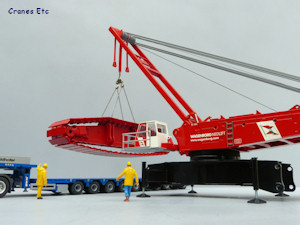 |
| Self assembling
the crawler tracks. |
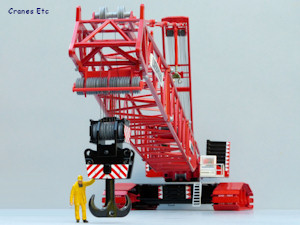 |
| The 300t hook
fitted. |
 |
| Tracks are wide.
|
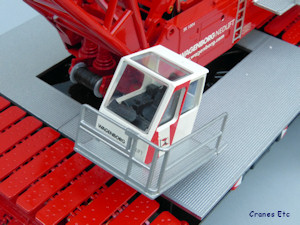 |
| Tilting cab. |
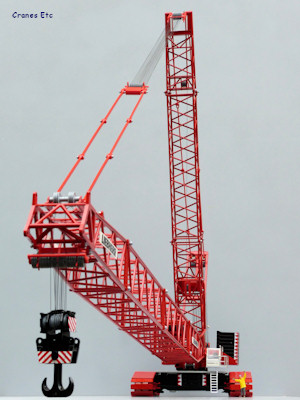 |
| Large main boom
and derrick fitted. |
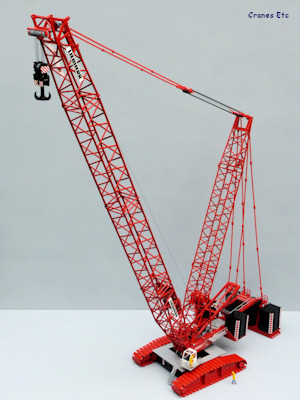 |
| Rigged with the
suspended ballast tray. |
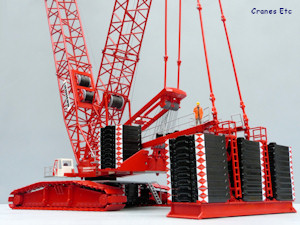 |
| Tonnes of
ballast for a big lift.
|
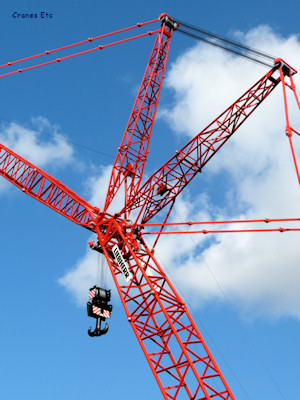 |
| Wagenborg
colour scheme is attractive.
|
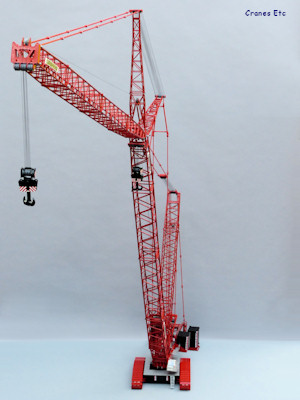 |
| Big model. |
|
 Comment on this model. Comment on this model.
This is a model of the giant
Liebherr 1750 Crawler Crane which has a lifting capacity
of 750 tonnes. It has a maximum height of lift of 191m
and can be configured in a variety of ways including
adding special boom sections for wind turbine work.
It is also a sister machine to the
Liebherr LG 1750 Truck Mounted
Crane as many of the crane components are shared.
The version reviewed here is in the colours of
Wagenborg Nedlift, the Netherlands heavy lifting and
transport specialist. It is configured with a suspended
ballast frame arrangement.
Packaging
The model box is very large and extremely heavy, and
care is advised in handling it. It consists of a
picture sleeve which wraps the three expanded
polystyrene trays which contain the model, complete with
a lid for the top tray. There were no defects or
missing parts on the review model.
A 26 page manual is included which is printed in black
and white, and two additional sheets cover the suspended
ballast tray in this
version of the model. It has photos of the box trays
with parts annotated so they can be identified during
the assembly process, although and not
every piece is actually identified.
The assembly instructions
themselves are a series of staged photographs with the components
at each stage identified. Although the pictorial stages are fine,
the instructions fall short in the area of reeving the model.
There is a lack of a clear description of which winch drums
should control which function and where for example the
hoist ropes should run through the derrick. There
are reeving diagrams for the three sets of luffing gear
which are barely clear enough in black and white, but nothing
at all for reeving the hooks. It is a little disappointing
that the model falls a bit short in this area.
With that said, the assembly of the model is enjoyable
because Conrad's model engineering is top notch and the model
parts fit together very well indeed. As usual the reeving can try the
patience and this model is no exception. Stringing
up the hooks can lead to frustration as the string has a
tendency to bounce off the pulleys so the best bet is to
keep the string under tension at all times.
Full assembly of the complete configuration takes
several hours.
Detail
Each track frame is a large single piece consisting of
the main structural frame which has some interesting
casting detail. The drive sprockets are detailed and
bear the Liebherr name finely cast in. The track pads
are wide representing the 2m track pad option of the
real crane.
The centre section is a heavy piece and has the crane
body permanently attached. There are four outriggers
with jacks for lifting the crane body off a transport
vehicle. The outrigger pads are plastic but they are
not visible when the model is fully assembled. Also
spanning the track frames is a pair of brackets which fit onto
clips which attach onto the frames, and these support
three ballast plates each. These are the usual high
standard of casting including lifting lugs. On top
of the plates, silver textured walkways rest to provide
a platform for operator access and this part of the model
is completed by a couple of ladders and handrails.
A heavy toothed slewing ring sits on top of the undercarriage.
The crane body has a swinging cab which includes a walkway
and handrails but does not have some of the smaller details
such as wipers and mirrors. Inside, the cab has a
representation of controls and screens. The crane
body is heavy and has essential detail within the casting
representing panels and handles, and there are a couple
of ladders. At the front, the three slewing motors
look realistic, and they are complete with drive pinions,
although there are no hydraulic lines modelled.
There is a small auxiliary winch at the front and this
looks best when it has some thread wound on.
The Wagenborg livery is very attractive and includes
good graphics on the sides of the body including a fleet
number.
Moving
to the rear, the engine enclosure includes textured surfaces
and grilles and a metal exhaust pipe. The grille detail
also extends to the underside of the body. Heavy ballast
trays hang off each side at the rear. The A-frame includes
the hydraulic hook which the crane uses to assemble its
own tracks.
The suspended ballast frame pins to the back of the
crane and has a textured walking surface and nicely
rendered metal handrails. Ladders descend to the
support bed, and the support mechanism is detailed
within the casting, but the cylinders are non
functioning. The ballast plates are very good,
with lifting eyes that facilitate lifting with suitable
chains to make an interesting pose.
The boom and jib sections are all fine examples of
Conrad’s model engineering ability. Geometrically
perfect, they fit together extremely well. They are
joined together by the usual Conrad plastic pins which
work fine. At the crane body, spring loaded back stops
prevent the booms from over luffing and these parts are
all metal. All of the pulleys are plastic, and are free
rolling. The suspension bars are plastic and pin together
maintaining a true line when under load so they are much
better than those supplied with the early versions of
the model.
The luffing bridles are plastic, presumably to keep the
weight of these parts down so that the lines do not sag
unduly. Another plastic part is the pulley holder on
the main boom head and this would certainly have been
better in metal like the luffing jib head, which is a heavy piece. Plastic
Liebherr signboards are fixed to the boom and jib.
Two hooks are provided and these are impressive. Consisting
of the same modular components, they strip down to separate
pulley block and hook assemblies with only the pulleys and
pins being plastic. The larger hook also has clip
on ballast weights to keep the tension in the ropes.
Features
The model features working jacks to lift the crane body
off of a transport vehicle. These rotate out from
the cross frame and screw down to lift the crane.
The crawler tracks roll nicely and are mounted on a
frame which is spring loaded at one end which keeps the
tension and also enables removal of the tracks.
The cab is a swinging type which tucks in at the front
when in transport mode. It can also be tilted to allow
the operator comfort when the crane is lifting at
height.
A working hydraulic hook is provided which is connected
to the A-frame so that the crane can assemble its own
tracks. This has a suitably stiff cylinder so that
the hook can be posed at a variety of lengths and hold a
load without the ram ‘bleeding’.
All three hoist drums in the crane body are spring
loaded and resistant to slipping under load. They are
operated using keys which push through holes in the
crane body and they have a slotted end so they can be
driven using a powered screwdriver. The three hoist
drums mounted in the boom and derrick
sections are operated similarly so that all the
functions of the real crane can be replicated.
The boom drums are also pinned in position so are
removable.
The suspended ballast frame is attached to the
crane with a telescopic mechanism which allows it to be
set at three different extension radii depending on the
lift to be undertaken.
The large 600t hook is modular and can be broken down to
form a separate 300t hook.
A major strength of the model is the ability to build it
in a number of configurations. Booms and jibs can be
any length desired. A luffing jib can be mounted, or
not, and the derrick is also an optional fixture. Similarly
a variety of ballast weight configurations is available.
The modular construction also allows it to be used to
make up a large number of transport loads.
Quality
The quality of manufacture is very good indeed with the
metal lattice sections straight and true, and it fits
together really well.
The paintwork and graphics are very good and plastic is kept to
a minimum.
Price
This is a limited edition and is a significant amount of
metal so it is not cheap. It is good value for
what is offered.
Overall
Conrad has produced a very large model which fully
erected is an imposing 2m high and although the stresses
get significant with a model of this size there is never the feeling that
it cannot take the loads applied.
The display possibilities are excellent because of the
different configurations possible, and it can be broken
down into transport size loads.
Although the manual could be a little better there is no
doubt that in Wagenborg livery this is an outstanding model.
Footnotes
The model first appeared at the Nuremberg Toy Fair
in February 2005 in
Liebherr colours. In 2007 the sister crane, the truck mounted
LG1750, was announced by Conrad as
model 2737.
This Wagenborg version appeared in September 2012.
|
|
|
|
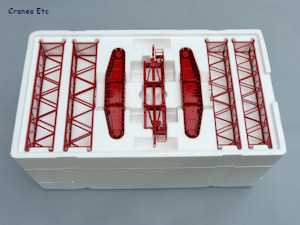 |
| The top tray holds
the tracks, suspended ballast tray and lattice sections. |
 |
| The bottom tray
has the ballast plates and various sections.
|
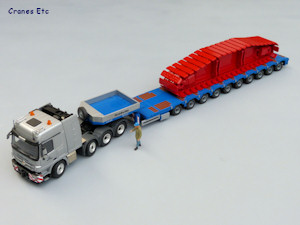 |
| A heavy crawler
track on the road. |
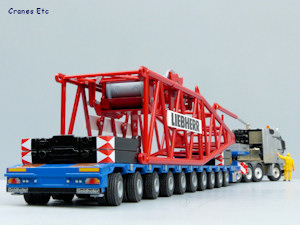 |
| Crane parts are
large. |
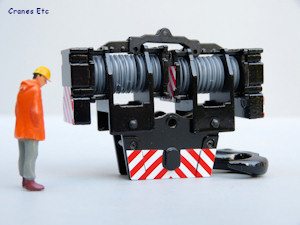 |
| Large 600t hook
is modular. |
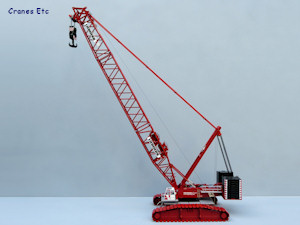 |
|
Rigged with a short main boom only. |
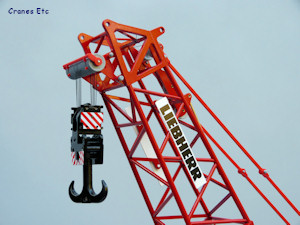 |
| The main boom
head. The pulley arrangement is pinned and can be
left off if the luffing jib is fitted.
|
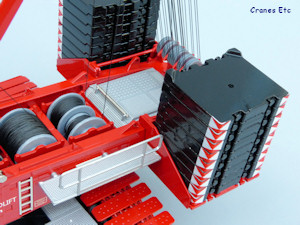 |
| Textured engine
cover. The winch drums and pulleys are plastic. |
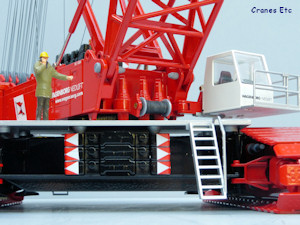 |
| Ballast on
the undercarriage. Putting some rope on the
auxiliary winch looks better. |
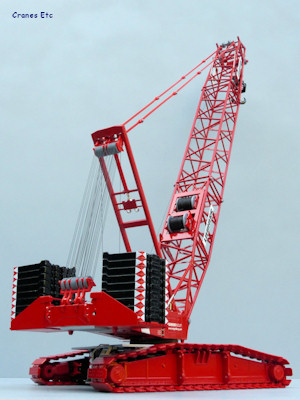 |
| Heavy crawler
track frames. |
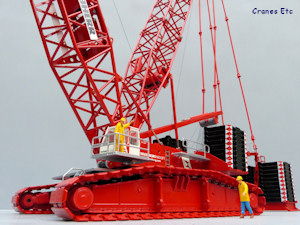 |
| Big iron. |
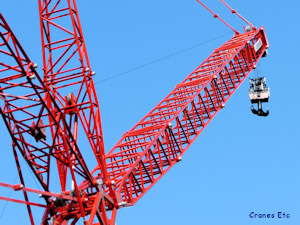 |
| Luffing jib. |
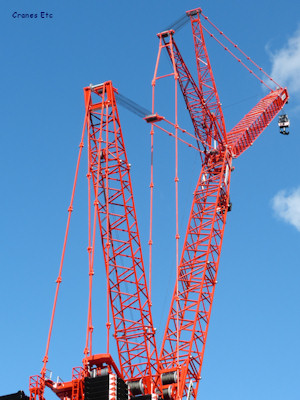 |
| Very realistic
appearance. |
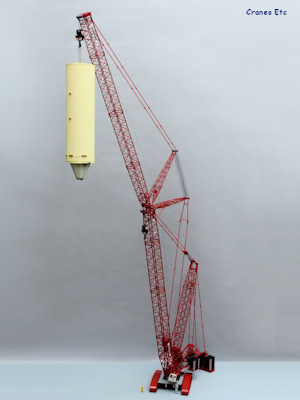 |
| Lifting a
fermentation tank with ease. |
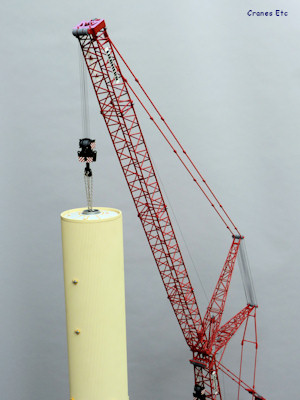 |
| Impressive
model engineering. |
|

